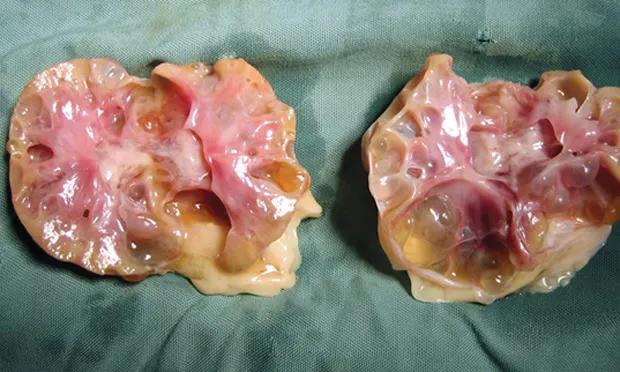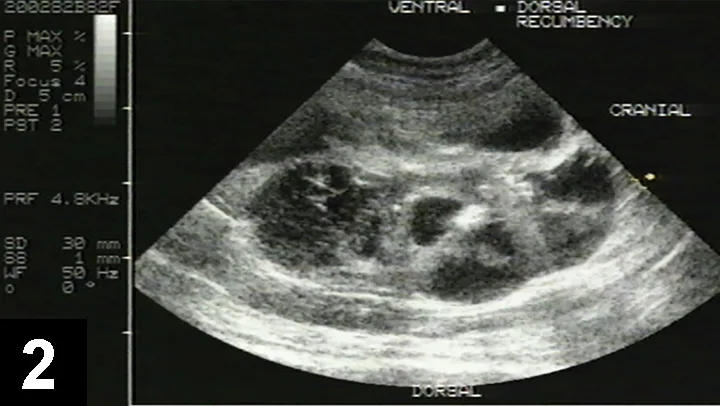Feline Polycystic Kidney Disease
Margie Scherk, DVM, DABVP (Feline Practice), catsINK

Figure 1, main image: Necropsy of both sectioned kidneys from a cat with PKD; note fluid-filled cysts of varying sizes and obliteration of large portions of both the cortex and medulla. Only scant amount of renal parenchyma (pink) remains. Image courtesy of Dr. Susan Little.
Profile
Definition
Polycystic kidney disease (PKD) is the most common inherited renal disease of cats.1
PKD is one of the leading causes of chronic kidney disease (CKD) in Persians and related breeds.2
PKD progresses slowly as portions of the cortex and medulla are replaced by cysts (Figure 1).
Cysts compress functional parenchyma as they enlarge, thus decreasing kidney function.
Cyst number and rate of growth are highly variable.2
Systems
Kidneys ± liver and/or pancreas1,3-6
Genetic Implications
Autosomal dominant (AD) mode of inheritance with variable penetrance
Affected cats are heterozygotes; homozygous expression is embryonic lethal.7,8
Mutation in PKD1 gene leads to a C>A transversion in exon 29, leading to a stop codon.
This is the basis for genetic testing.<sup7-9 sup>
Variable expression is seen in related and unrelated individuals.
Cyst size and number varies from cat to cat and parent to offspring.
Mildly affected queens can produce offspring with severe disease and vice versa.2
Incidence & Prevalence
Affects approximately 6% of cats.
May affect up to 37%–50% within Persians and related breeds.10-13
In other breeds, prevalence may be as high as 16%.14
Geographic Distribution
Worldwide
Signalment
Breed Predilection15
High risk: Persian, Himalayan, exotic shorthair breeds, British shorthair breeds
Moderate risk: Asian, Birman, Bombay, Burmilla, Cornish rex, Devon rex, ragdoll, Snowshoe, Tiffanie
Low risk: Abyssinian, Angora, Balinese, Bengal, Burmese, Chartreux, Egyptian Mau, Korat, Maine coon, Norwegian forest cat, Ocicat, Oriental longhair, Oriental shorthair, Russian blue, Siamese, Singapura, Somali, Tonkinese, Turkish van
Cystic renal disease occurs with a low prevalence in the Maine coon and is unrelated to the PKD1 mutation observed in Persians and related breeds.16
Despite conscientious warnings and screenings by breeders, the ragdoll has a low prevalence of PKD (<3%).17,18
Age & Range
Affected cats usually develop CKD signs between 3–10 years of age (mean, 7 years).
Sex
No sex predilection
Pathophysiology
Polycystin-1, encoded by the PKD1 gene, is a renal tubule membrane glycoprotein needed for epithelial cell proliferation and differentiation.
Substitution of a cytosine base for an adenine base results in insufficient polycystin-1 production.
Insufficient polycystin-1 results in tubule remodeling and cyst formation.
Cysts may develop in the embryo.*
This is under investigation.
Stress may cause CKD manifestation in predisposed individuals.19
One study showed increased mean arterial pressures and aldosterone: renin ratios20; one therapeutic case series showed no resolution of hypertension after surgical drainage.21
However, PKD does not result in hypertension in cats as it does in humans and dogs.22
Cats that develop CKD secondary to PKD may be at risk for hypertension.
History & Clinical Signs
Many cats remain subclinical for an extended time.
History and clinical signs are those typical of CKD:
Polyuria, polydipsia, dehydration, lethargy, inappetence/anorexia, nausea/vomiting, constipation, weight loss, muscle wasting, and oral ulceration
Cysts may also result in hematuria and increased risk for urinary tract infections.23
Cats with large cysts have irregular, large kidneys.
Cysts are often bilateral.
Patients may present with signs associated with liver disease, albeit rarely.
6%–68% of affected cats have hepatic cysts.4,24
Rarely, hepatic encephalopathy may be present with hepatic cysts and fibrosis.25,26
Table: PKD Differential Diagnosis
Diagnosis
Definitive Diagnosis
CBC, serum chemistry, and urinalysis are required for CKD diagnosis.
Ultrasonography and genetic testing are required to definitively diagnose PKD.
Cats may not have the same genetic mutation.27
Cysts may not be visible in very young cats.27
Genetic testing identifies only the AD form of PKD, not other forms of cystic kidney disease.
Ultrasonography is sensitive for PKD detection, assesses severity, is repeatable, and is useful for monitoring disease progression.28
Differential Diagnosis
Renomegaly: Lymphoma, feline infectious peritonitis granulomatous nephritis, perinephric pseudocysts, acquired renal cysts, hydronephrosis, acromegaly
See PKD Differential Diagnosis
Laboratory Findings
Depending on CKD stage, increases in BUN and creatinine, low urine-specific gravity secondary to decreased concentrating ability, alterations in electrolytes, and anemia may be present.
Figure 2: Ultrasound image of a polycystic kidney in a young Himalayan cat with multiple hypoechoic cysts.

Imaging
Radiography is not useful in early stages.
Once large cysts are present, renomegaly and asymmetry of renal size will be apparent ± dystrophic calcification.
Ultrasonography can typically identify renal cysts >2 mm in diameter (Figure 2).
Diagnostic sensitivity of ultrasound is 91% in cats >9 months of age.27
Phenotypic variation in cyst size and number is considerable.
Cysts are smooth, round, or irregular anechoic structures of variable size located throughout the renal cortex and medulla and grow over sequential assessment.2,29
Affected kidneys have indistinct corticomedullary junctions and foci of mineralization.3,29
Absence of cysts at youth does not guarantee the cat will not develop them later.
Cysts may be found as early as 6–8 weeks of age.
False negatives at this age are a result of small cysts or operator inexperience.
Kittens from affected lines should be screened at ~10 months of age.<sup3 sup>
Genetic Testing (PCR)
Detects PKD1 gene
Useful for early diagnosis in potential breeding stock
Buccal swab can be used in very young kittens.
Care must be taken if the kitten is not weaned; milk may contaminate the sample.
In preweaned or older cats, blood sample may be used in lieu of buccal swab.
Several tests are available.7,8
Postmortem Findings & Histopathology
Cysts are focal dilations of the renal tubules.
Varying amounts of normal renal parenchyma remain surrounded by fibrous tissue.
Treatment
Medical
No definitive cure; condition is inherited, irreversible, and progressive.
Therapy reflects IRIS stage (iris-kidney.com) with in-hospital or home fluid therapy, potassium supplementation, phosphate binders, H2-receptor antagonists, antiemetics, appetite stimulants, and erythropoietin as needed.
When present, CKD hypertension should be managed with amlodipine.
When present, proteinuria should be managed with benazepril or telmisartan (eg, an angiotensin receptor blocker).
Urinary tract infection must be treated with appropriately sensitive antimicrobials to prevent secondary cyst infection and sepsis.
Analgesics may be warranted.
Surgical
Cyst drainage fails to slow progression but may reduce discomfort.
Ultrasound-assisted drainage and alcoholization has been evaluated.21
Nutritional
If muscle wasting is not present, a renal diet may be considered after IRIS Stage 3.
Appetite stimulants may be beneficial; caloric and protein requirements should be calculated.
Short-term feeding tubes may ensure adequate nutrition is received.
Client Education
Knowing which cats are affected allows for planned mating to reduce PKD.
All Persians and related cats and cats with known familial risk should be screened.
Combining ultrasound with genetic testing improves diagnostic yield.
Some cats with cystic kidney disease are not PKD1 positive and do not have PKD.
Complete elimination of all affected Persians from breeding programs would reduce the diversity of the breed and may lead to other undesirable characteristics.
Mating an affected progenitor with a healthy individual results in 50% of descendants being disease free; this type of crossing helps avoid losing a genetic line while conserving genetic diversity.
Follow-Up
Patient Monitoring
Cats with PKD should be monitored q6–12mo via ultrasound to evaluate cyst progression and detect changes indicating supportive care for emerging CKD.
Once CKD is present, cats should be monitored as often as is indicated.
In General
Relative Cost
Diagnostics:
Ultrasound: $$
Genetic testing (PCR): $
CKD treatment: $$–$$$$$
Prognosis
If minimally affected: Good
If rapidly progressive: Poor
Prevention
Affected individuals should be identified to enable planned breeding.
General Comments
Breeders are encouraged to use the International Cat Care PKD Negative Register to select breeding stock and register negative cats (noting whether negative result is based on ultrasound or genetic screening).
*Personal correspondence with Leslie Lyons, MS, PhD; August 2014